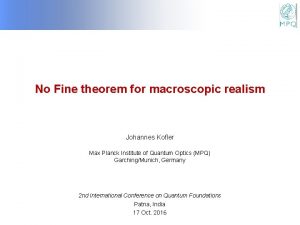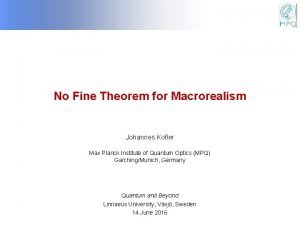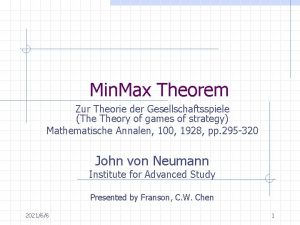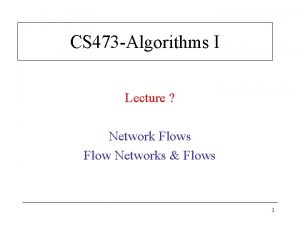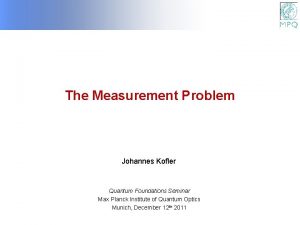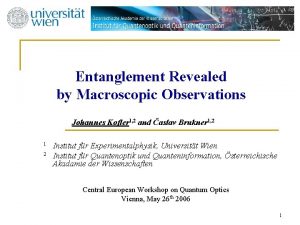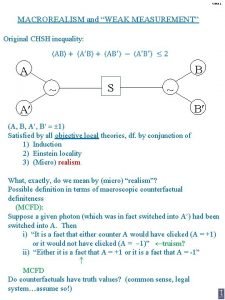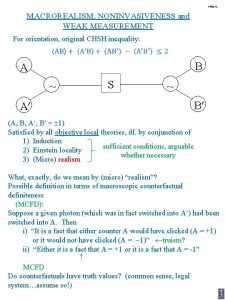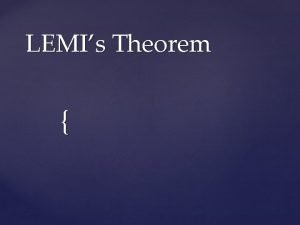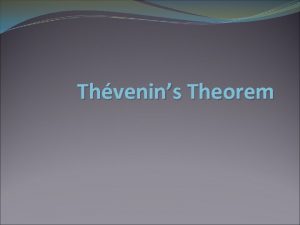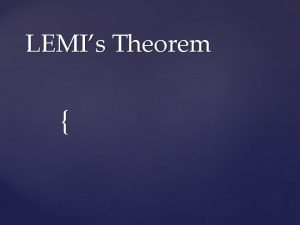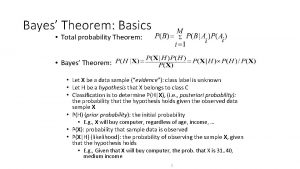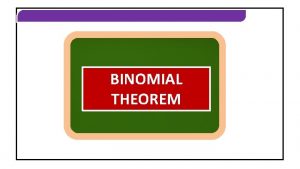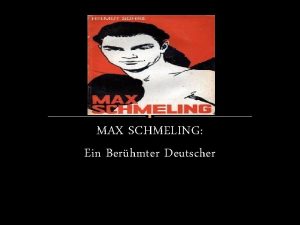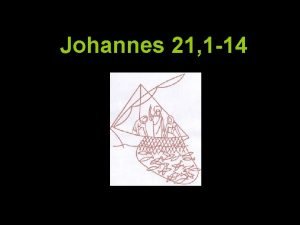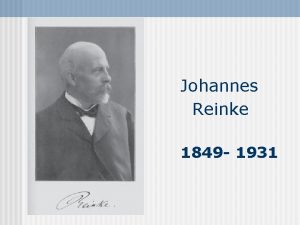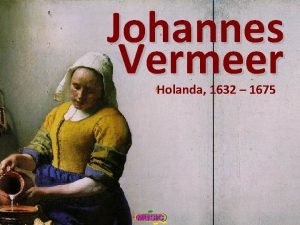No Fine Theorem for Macrorealism Johannes Kofler Max












![No signaling (in time) [LR] No-signaling (NS): “A measurement on one side does not No signaling (in time) [LR] No-signaling (NS): “A measurement on one side does not](https://slidetodoc.com/presentation_image_h/dd24cf58b5e042b33cbb80cff057eeec/image-13.jpg)











- Slides: 24

No Fine Theorem for Macrorealism Johannes Kofler Max Planck Institute of Quantum Optics (MPQ) Garching/Munich, Germany Quantum and Beyond Linnaeus University, Växjö, Sweden 14 June 2016

Acknowledgments Časlav Brukner Lucas Clemente J. K. and Č. Brukner, PRA 87, 052115 (2013) L. Clemente and J. K. , PRA 91, 062103 (2015) L. Clemente and J. K. , PRL 116, 150401 (2016)

Quantum-to-classical transition With photons, electrons, neutrons, atoms, molecules Measurement problem With cats?

Candidates 1 2 Heavy molecules 1 (position) Superconducting devices 2 (current) Atomic gases 3 (spin) Nanomechanics 4 (position, momentum) S. Gerlich et al. , Nature Comm. 2, 263 (2011) M. W. Johnson et al. , Nature 473, 194 (2011) 3 4 B. Julsgaard et al. , Nature 413, 400 (2001) G. Cole et al. , Nature Comm. 2, 231 (2011)

Motivation and outline ? • ? How does our macroscopic & classical world arise out of quantum mechanics? - • Within quantum mechanics: Decoherence Coarse-grained measurements - Altering quantum mechanics: Spontaneous collapse models (GRW, Penrose, etc. ) Are there macroscopic superpositions (“Schrödinger cats”)? • Quantum mechanics: in principle yes Macrorealism: no, Leggett-Garg inequalities (LGIs) must hold This talk: Comparison of local realism and macrorealism Alternative to the LGIs

Local realism External world Observers

Local realism 1. Realism is a worldview ”according to which external reality is assumed to exist and have definite properties, whether or not they are observed by someone. ” 1 [Existence of hidden variables] 2. Locality demands that ”if two measurements are made at places remote from one another the [setting of one measurement device] does not influence the result obtained with the other. ” 2 3. Freedom of choice: settings can be chosen freely Joint assumption: Local realism (LR) or “local causality”: 2 A = ± 1 B = ± 1 a b • LR Bell inequalities (BI): A 1 B 1 + A 1 B 2 + A 2 B 1 – A 2 B 2 2 - very well developed research field - important for quantum information technologies (qu. cryptography, randomness certif. ) - loophole-free experiments exist (photons, NV centers) 1 2 J. F. Clauser and A. Shimony, Rep. Prog. Phys. 41, 1881 (1978) J. S. Bell, Physics (New York) 1, 195 (1964)

The local realism polytope etc. Fine theorem: 1 There exists a global joint probability distribution P(A 1, A 2, B 1, B 2, ) for all outcomes whose marginals are the experimentally observed probabilities There exists a local hidden variable (i. e. local realistic) model for all probabilities All Bell inequalities are satisfied Picture: Rev. Mod. Phys. 86, 419 (2014) 1 A. Fine, PRL 48, 291 (1982)

Macrorealism

Macrorealism 1. Macrorealism per se: ” A macroscopic object which has available to it two or more macroscopically distinct states is at any given time in a definite one of those states. ” 1 2. Non-invasive measurability: “It is possible in principle to determine which of these states the system is in without any effect on the state itself or on the subsequent system dynamics. ” 1 3. Freedom of choice & Arrow of Time • Joint assumption: Macrorealism (MR): t 0 • MR restricts temporal correlations Leggett-Garg inequality (LGI): K : = Q 1 Q 2 + Q 2 Q 3 + Q 3 Q 4 – Q 1 Q 4 2 • Quantum mechanics (QM): = non-invasiveness t 0 A B t. A t. B Q Q ± 1 t 2 t 3 KQM = 2 2 2. 83 1 A. J. Leggett and A. Garg, PRL 54, 857 (1985) t 4

LGI violations for microscopic systems

Analogy LR – MR “One-to-one correspondence” Local realism (LR) Macrorealism (MR) Realism Macrorealism per se Locality Non-invasiveness Freedom of choice Bell inequalities (BI) for spatial correlations Leggett-Garg inequ. (LGI) for temporal correlations Now the analogy will break
![No signaling in time LR Nosignaling NS A measurement on one side does not No signaling (in time) [LR] No-signaling (NS): “A measurement on one side does not](https://slidetodoc.com/presentation_image_h/dd24cf58b5e042b33cbb80cff057eeec/image-13.jpg)
No signaling (in time) [LR] No-signaling (NS): “A measurement on one side does not change the outcome statistics on the other side. ” A B a b [MR] No-signaling in time (NSIT): “A measurement does not change the outcome statistics of a later measurement. ” 1 A t 0 t. A B t. B LR BI NS BI necessary for LR tests NS “useless” QM MR LGI NSIT QM 1 J. K. and Č. Brukner, PRA 87, 052115 (2013) LGI not essential for MR tests alternative: NSIT (interference) more physical, simpler, stronger, more robust to noise

Necessary conditions for MR Variety of necessary conditions for macrorealism 1 Arrow of time (Ao. T): e. g. P 1(Q 1) = P 12(Q 1) 1 L. Clemente and J. K. , PRA 91, 062103 (2015)

Necessary and sufficient for MR Sufficient 1 for LGI 012 Necessary and sufficient 2 for MR 012 Is there a set of LGIs which is necessary and sufficient for MR? 1 O. J. E. Maroney and C. G Timpson, ar. Xiv: 1412. 6139 2 L. Clemente and J. K. , PRA 91, 062103 (2015)

Comparison of LR and MR LR test MR test i = 1, 2, …, n n parties i (Alice, Bob, Charlie, …) n measurement times i si = 0, 1, 2, …, m m+1 possible settings for party i m+1 possible settings for time i (s = 0: no measurement is performed) qi = 1, 2, …, possible outcomes for party i possible outcomes for time i (for s = 0: = 1) No. of unnorm. prob. distributions: norm. conditions: Positivity conditions: Dimension of the prob. polytope (P):

Comparison of LR and MR LR test MR test No-Signaling (NS) conditions Arrow of time (Ao. T) conditions BIs are hyperplanes in NS polytope LGIs are hyperplanes in Ao. T polytope NSIT conditions L. Clemente and J. K. , PRL 116, 150401 (2016)

Local realism versus macrorealism L. Clemente and J. K. , PRL 116, 150401 (2016)

No Fine theorem for MR Fine’s theorem in fact requires NS in its proof: NS (obeyed by QM) has two temporal ‘cousins’: Ao. T (obeyed by QM) NSIT (violated by QM) LGIs can never be sufficient for MR (except the “pathological case” where they pairwise form all NSIT equalities) LGIs are non-optimal witnesses LGIs needlessly restrict parameter space where a violation of MR can be found Experiments should use NSIT criteria instead of LGIs L. Clemente and J. K. , PRL 116, 150401 (2016)

Experimental advantage • Superconducting flux qubit Coherent superposition of 170 n. A over a 9 ns timescale • Experimental visibility “is far below that required to find a violation of the LGI” • Violation of a NSIT criterion (with ~80 standard deviations) • Paves the way for experiments with much higher macroscopicities G. C. Knee, K. Kakuyanagi, M. -C. Yeh, Y. Matsuzaki, H. Toida, H. Yamaguchi, S. Saito, A. J. Leggett, W. J. Munro, ar. Xiv: 1601. 03728

Conclusion & Outlook • Are macoscopic superpositions possible? QM: yes, MR: no • Experimental tests are still many years or even decades away • LGIs have been used (theoretically and experimentally) for many decades • LGIs thought to be on equal footing with BIs • The analogy breaks: NS obeyed by QM NSIT not obeyed by QM • Fine theorem: for LR, not for MR • NSIT is a better (simpler and stronger) criterion than the LGIs • First experiments already take advantage

Appendix

Locality vs. non-invasiveness How to enforce locality? How to enforce non-invasiveness? Space-like separation Ideal negative measurements Special relativity guarantees impossibility of physical influence Taking only those results where no interaction with the object took place ? ? – 1 +1 ü Bohmian mechanics Space-like separation is of no help: non-local influence on hidden variable level Ideal negative measurements are of no help: wavefunction “collapse” changes subsequent evolution Realistic, non-local Macrorealistic per se, invasive

Mach-Zehnder interferometer LGI 012 NSIT(1)2 violated in specific parameter regimes violated for all q, , R 1, R 2 except measure 0 J. K. and Č. Brukner, PRA 87, 052115 (2013)
 Johannes kofler
Johannes kofler Johannes kofler
Johannes kofler Green theorem is a relation between
Green theorem is a relation between Absolute min and max
Absolute min and max Zur theorie der gesellschaftsspiele
Zur theorie der gesellschaftsspiele Flow g cut
Flow g cut Anatomi organ reproduksi
Anatomi organ reproduksi Smärtskolan kunskap för livet
Smärtskolan kunskap för livet Bris för vuxna
Bris för vuxna Teckenspråk minoritetsspråk argument
Teckenspråk minoritetsspråk argument Novell typiska drag
Novell typiska drag Trög för kemist
Trög för kemist Delegerande ledarskap
Delegerande ledarskap Ellika andolf
Ellika andolf Mindre än tecken
Mindre än tecken Blomman för dagen drog
Blomman för dagen drog Redogör för vad psykologi är
Redogör för vad psykologi är Mat för unga idrottare
Mat för unga idrottare Lek med former i förskolan
Lek med former i förskolan En lathund för arbete med kontinuitetshantering
En lathund för arbete med kontinuitetshantering Ledarskapsteorier
Ledarskapsteorier Offentlig förvaltning
Offentlig förvaltning Datorkunskap för nybörjare
Datorkunskap för nybörjare Kvinnlig mantel i antikens rom
Kvinnlig mantel i antikens rom Steg för steg rita
Steg för steg rita
